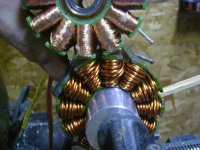Hi All,
Someone said to ask questions..
I see a lot of posts that say things like 'it will go X mph because its 36 v (or insert your own voltage)
But isn't the real information in the watts? I mean horsepower to weight ratios have always been the telling fact in go fast cars....and watts = horsepower x fancy math.
And I am sure I weigh a bunch.
I guess w/o the smart aleck my question would be: To go a certain speed I have to develop (and deliver to the road) a certain wattage, correct?
To me then, this means my trike is always gonna require more amps/have less range than a 2 wheeler, or when I add a laptop to the pans I am gonna lose a mile in range.
Yes there is rolling resistance, trebly so on a trike, and aero is a factor, and that's all a drag too. But aren't you really interested in the same thing as John Force?
--T
Someone said to ask questions..
I see a lot of posts that say things like 'it will go X mph because its 36 v (or insert your own voltage)
But isn't the real information in the watts? I mean horsepower to weight ratios have always been the telling fact in go fast cars....and watts = horsepower x fancy math.
And I am sure I weigh a bunch.
I guess w/o the smart aleck my question would be: To go a certain speed I have to develop (and deliver to the road) a certain wattage, correct?
To me then, this means my trike is always gonna require more amps/have less range than a 2 wheeler, or when I add a laptop to the pans I am gonna lose a mile in range.
Yes there is rolling resistance, trebly so on a trike, and aero is a factor, and that's all a drag too. But aren't you really interested in the same thing as John Force?
--T



